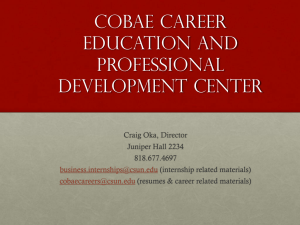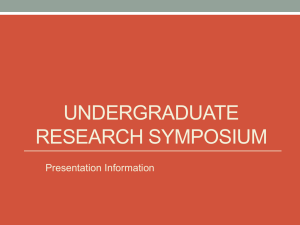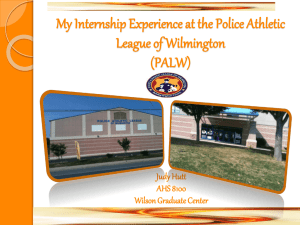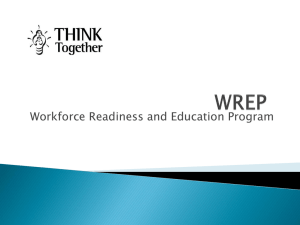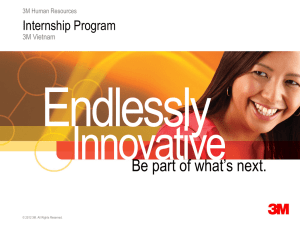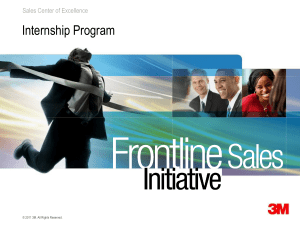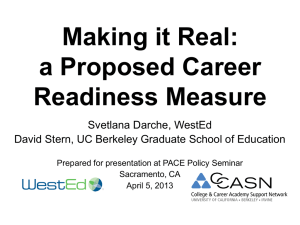Experience
advertisement
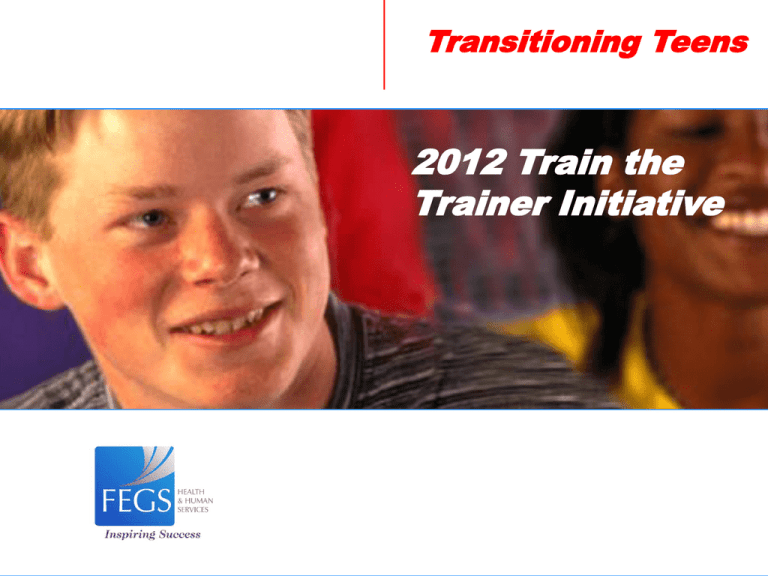
Transitioning Teens 2012 Train the Trainer Initiative Introductions • Introduce yourself to you tablemates including: • Name • Where you work • What you do • Develop a table mascot and create a poster depicting the mascot. Include all of your names and affiliates on the poster. Goals for the Day • Explore components of F∙E∙G∙S’s young adult Career Development curriculum • Participate in career development activities that can be used with young adults • Share tools and techniques used in your programs to support the career development of participants Intro Activity On an index card: • Write your name Draw an image that depicts the profession that you wanted to pursue when you were a teenager • Share with the larger group Education & Youth Services EYS Mission: To help at-risk young people reach their potential and become self-sufficient. The Work We Do: Each year, EYS helps 4,500 young people as they work to graduate from high school, obtain a GED, enter college, prepare for and obtain employment, develop a career path and make the transition to adulthood. Our Approach: CareerFirsts® Comprehensive approach grounded in the principles of youth development. Recognizes that, in addition to academic and employment support, at-risk youth need significant support and assistance in their social and emotional development as they face myriad challenges in their families, communities, at school and at work. Lessons Learned Work-readiness training did not always get our participants “work ready.” Over a quarter of our participants failed in an internship or job placement but had successfully completed work-readiness training. The skills identified most by employers as essential for the workplace, (professionalism, teamwork, communication)1 were not the skills we assessed in our work readiness program. Over a quarter of our participants failed in an internship or job placement but had successfully completed work-readiness training. The skills identified most by employers as essential for the workplace, (professionalism, teamwork, communication)1 were not the skills we assessed in our work readiness program. Program Impact: We replaced work readiness training with a rigorous performance-based assessment to better match participants with work-based learning opportunities, and focused on our internship as the true training site. Lessons Learned A subset of participants were unprepared for internship program. Over a quarter of our participants failed in an internship or job placement but had successfully completed work-readiness training. For high-school graduates, a majority of employers cited the following applied skills as “very important” for successful entry-level performance: 80.3% Professionalism/Work Ethic 74.7% Teamwork/Collaboration 70.3% Oral Communications1 Program Impact: We focused on our internship as a work-based learning experience that included ongoing assessment of participants’ progress. Lessons Learned A subset of participants were unprepared for internship program. Over a quarter of our participants failed in an internship or job placement but had successfully completed work-readiness training. The skills identified most by employers as essential for the workplace, (professionalism, teamwork, communication)1 were not the skills we assessed in our work readiness program. Over a quarter of our participants failed in an internship or job placement but had successfully completed work-readiness training. The skills identified most by employers as essential for the workplace, (professionalism, teamwork, communication)1 were not the skills we assessed in our work readiness program. Program Impact: We partnered with five foster care agencies to create the sheltered internship model. FEGS Career Development Components • Exploration: Career readiness begins with the exploration of interests, abilities and skills that young adults already have or would like to develop • Exposure: Young adults open new career options and develop career readiness through exposure to the workplace • Experience: Engagement in work environments through structured and independent internship opportunities helps young adults gain valuable skills and experience Exploration Career readiness begins with exploration of the interests, abilities and skills that youth already have or would like to develop Topics include: • Self Awareness • Lifestyle and Responsibility • Setting Goals • Basic Economics • Personal Finance • Money Management Exploration Tools Tools: • WOWI: www.wowi.com • NY State Career Zone: http://www.nycareerzone.org/ • Real Game Exposure Career Youth open new career options and develop career readiness through exposure to the workplace and the college environment Topics include: • • • • • • Workplace Culture Exposure to Careers Getting a Job On the Job College Planning Applying to College Exposure Tools Tools: • O-net http://www.onetonline.org/ • CareerZone: videos • Bureau of Labor Statistics: http://www.bls.gov/oes/curren oessrcst.htm Experience Engagement in work environments through structured and independent internship opportunities helps young adults to gain valuable skills and experience Topics include: • Preparing for Internships • Sheltered Internships • Independent Internships • From Internship to Job Exposure Tools Tools: • O-net http://www.onetonline.org/ • CareerZone: videos • Bureau of Labor Statistics: http://www.bls.gov/oes/curren oessrcst.htm Experience Tools Tools: • CareerFirsts® Assessment Rubric • CareerFirsts ® Online Management System • CareerFirsts ® Evaluations • Internship Seminar Curricula Sharing Promising Practices • How do you define work readiness for your participants? • Which interest inventory or career assessment tools are you currently using and do they work for your participants in supporting their goals in employment? • What supports do you think youth need to be successful in employment, i.e., training, employment programs, referrals, coaching, etc. Next Steps • Head, Heart, Foot • Evaluations • How can this IAJVS Network support your work?

